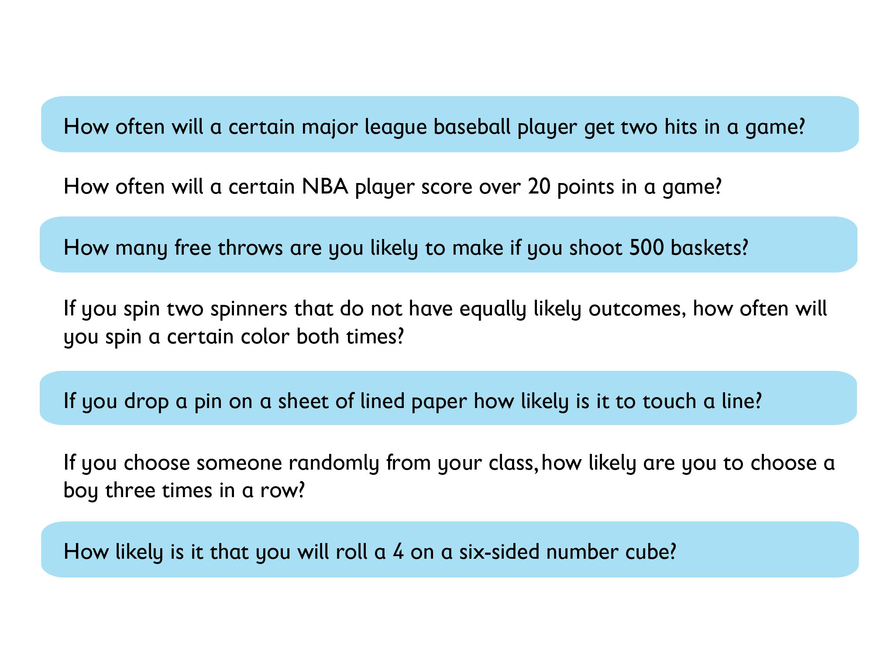- Author:
- Pearson
- Subject:
- Mathematics
- Material Type:
- Lesson Plan
- Level:
- Middle School
- Grade:
- 7
- Provider:
- Pearson
- Tags:
- License:
- Creative Commons Attribution Non-Commercial
- Language:
- English
- Media Formats:
- Text/HTML
Project Proposal

Overview
Students will form groups for the unit project, decide on a topic, and write up a project proposal. Students will also complete a Self Check that will be discussed in the next lesson.
Key Concepts
Students will apply what they have learned in the unit so far to determine a project. They will also apply their learning to complete a Self Check problem.
Goals and Learning Objectives
- Decide on a project topic and group.
- Write a project proposal.
Introduction to the Project
Lesson Guide
Have students look through the rubric alone for a few minutes before beginning a class discussion.
ELL: If ELLs don't know what a rubric is, show one and explain how it is used. Allow ELLs to use a dictionary if they wish.
ELL: Students have learned and retained information from prior learning experiences, but may not realize when to use that information. Teachers need to remind students of what they know, but also when to apply that knowledge. This strategy is sometimes referred to as “priming” background information. Priming background knowledge can be done in simple ways, such as merely stating “Remember when we learned... “ or “See how this concept applies in this situation, too?” It may also involve a more intensive overview of a topic.
Mathematics
Review with students what types of problems can be answered using probability. Remind students that probability problems can be answered in a few different ways, depending on the type of problem.
Strategies for solving probability problems include:
- Conducting an experiment (i.e., flipping a bottle cap)
- Performing a simulation (i.e., setting colors on the Spinner interactive and running trials)
- Collecting data (i.e., the number of houses in our city that was struck by lightning last year)
Projects can involve single events, independent compound events, or dependent compound events.
Opening
Introduction to the Project
In this unit, you will work with a group to complete a probability project about the topic of your choice. For your project, you will conduct an experiment, perform a simulation, or collect data.
Today you will choose a group and a topic for your project. You will work on this project over the course of the unit. You will be given some class time to work on your project, but you will also work on it outside of class.
At the end of the unit, your group will present your project to the class. Your teacher will use a project rubric to evaluate all the projects.
- Look through the rubric and briefly discuss it with your classmates.
Math Mission
Lesson Guide
Discuss the Math Mission. Students will choose a project group and project topic, and write a proposal for the project.
Opening
Choose a project group and project topic, and write a proposal for your project.
Choose a Project Topic
Lesson Guide
Have students form groups for the unit project. When determining the size and number of groups, keep in mind that group presentations and feedback discussions will take place over two lessons.
SWD: Decide how you will partner students together for this task. Partnering students by skill level will allow for more efficient provision of teacher support, while partnering students heterogeneously will promote cooperative teaching and learning opportunities for students with varying mathematical skills. Monitor partnerships to ensure all students progress. It is often best practice to pair students with disabilities with typically developing peers. Be mindful of all student partnerships, make sure that students are choosing partners that will be a positive influence.
Post the requirements and the rubric in the classroom for students to use as a resource as they work.
Work Time
Choose a Project Topic
Your project can involve a single event or a compound event. You can conduct an experiment, perform a simulation using one of the probability interactives, or collect data in order to answer a question (for example, how often will a certain major league baseball player get two hits in a game?)
- First, choose an experiment or topic that you are interested in. See the list for ideas.
- Next, think about where your data will come from. Will you conduct an experiment, use one of the probability interactives, or gather your own data?
- Then you will collect three sets of data of increasingly larger sample size to compare. You will analyze that data.
Write a Proposal
Lesson Guide
Explain that students need to be clear about what to do on their project by the end of Work Time. Check in with students as they work.
Mathematics
Make sure students understand how to collect their data for their experiment; either using one or more of the tools, or having a clear procedure to collect experimental results (such as how to drop a cup the same way each time).
As students work, ask them how they will display their results. Remind them that they can use any of the tools and interactives for the project.
Work Time
Write a Proposal
With your group, write a proposal to your teacher about the probability project you would like to work on.
- Present your topic.
- Explain the general process you will follow to complete your project, and what the final product will look like.
- Write the names of the people in your group.
- Submit your proposal to your teacher for approval.
Share Your Project Topic
Lesson Guide
Have students share their project proposals.
Mathematics
Questions to ask while groups are presenting:
- Will you conduct an experiment, perform a simulation, or collect data?
- How many trials will you conduct in each sample?
- Does this question have a theoretical probability?
- How will you display your results?
Mathematical Practices
Mathematical Practice 3: Construct viable arguments and critique the reasoning of others.
- As students share their project proposals, have the class discuss how the type of question influences the data collection method. Discuss whether or not the proposals have chosen appropriate questions, methods, and data displays.
Performance Task
Ways of Thinking: Share Your Project Topic
Listen as other students share their project topics with the class.
As your classmates present, ask questions such as:
- Why did you choose this project topic?
- What will you have to do to make the project successful?
- Have you thought about how you will present your project?
Bags of Marbles
Lesson Guide
This task allows you to assess students’ work and determine what difficulties they are having. The results of the Self Check will help you determine which students should work on the Gallery problems and which students would benefit from review before the assessment. Have students work on the Self Check individually.
SWD: Check to ensure that students understand the Self Check questions and directions. Provide multiple means of representing this information to promote student comprehension.
SWD: Provide clear feedback for students as they will attempt to solve problems or articulate concepts. This type of feedback guides students explicitly as they develop their thinking about
Assessment
Have students submit their work to you. Make notes about what their work reveals about their current levels of understanding and their different problem-solving approaches.
Do not score students’ work. Share with each student the most appropriate Interventions to guide their thought process. Also note students with a particular issue so that you can work with them in the Putting It Together lesson that follows.
Interventions
Student does not calculate the theoretical probability correctly.
- How many marbles are in the bag?
- How many of those are green?
- What is the definition of theoretical probability?
Student does not set up the proportion correctly to find the expected results.
- What does the ratio for the theoretical probability tell you?
- What part of the second ratio is the 200 trials?
- How would you make the number of favorable outcomes out of 200 trials equal to that ratio?
Student does not understand the likelihood of events.
- Are you more likely to get the exact results (or close) with 50 trials or 200?
- Does probability always work out as expected?
Student provides a poor explanation. For example, the student explains calculations rather than giving mathematical reasons.
- How can you convince a student in another class that your answer is correct?
Student provides an adequate solution to all questions.
- Can you find a different way of solving the problem?
Answers
- There are six possible outcomes, but only one is green, so P(green) = .
- Two of the six marbles are blue, so P(blue) = = . To find the expected results, a proportion can be set up:
You could expect to draw a blue marble about 67 times. - It is very unlikely that you would draw exactly 67 blue marbles. P(blue) = does not tell you how many times the blue marble will appear, but the likelihood that the blue marble will appear in any given draw.
- . You could expect to draw about 17 blue marbles in 50 trials. It is more likely that the experiment with 200 trials will result in close to 67 blue marbles than the experiment with 50 trials will result in close to 17 marbles. This is because the more trials there are, the closer the results get to the theoretical probability.
Formative Assessment
Self Check: Bags of Marbles
Complete this Self Check by yourself.
A bag contains 3 red marbles, 2 blue marbles, and 1 green marble.
- What is the probability of drawing a green marble?
- How many times would you expect to draw a blue marble in 200 trials, based on the theoretical probability?
- What is the likelihood that you would get this exact amount?
- How would these results compare to results for 50 trials?
Reflect on Your Work
Lesson Guide
Have students write a brief reflection before the end of the class. Review the reflections to find out what students thinking will be challenging about their projects.
Work Time
Reflection
Write a reflection about the ideas discussed in class today. Use the sentence starter below if you find it to be helpful.
What I think will be challenging about this probability project is…
